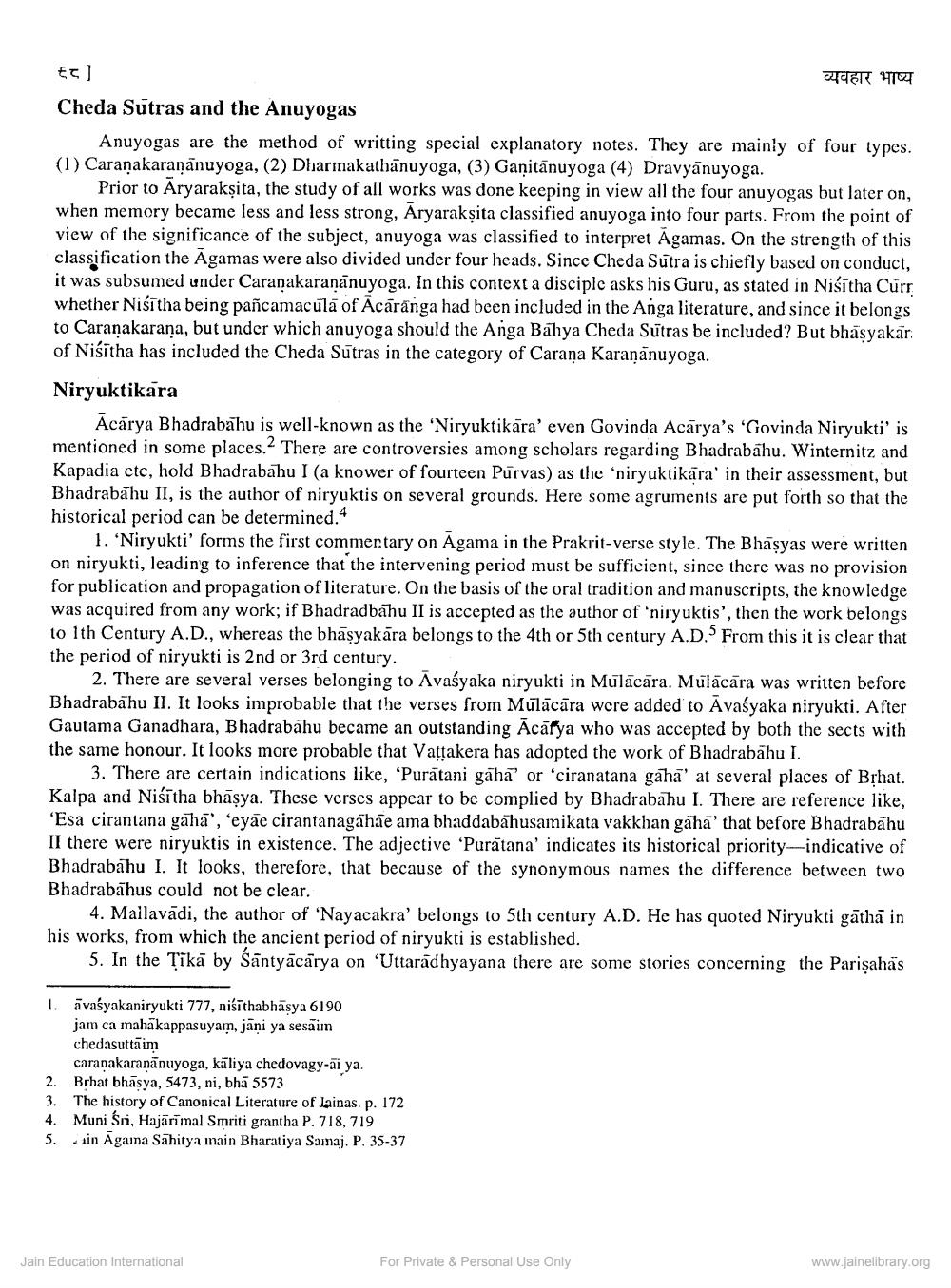________________
tc]
Cheda Sutras and the Anuyogas
Anuyogas are the method of writting special explanatory notes. They are mainly of four types. (1) Caranakaraṇanuyoga, (2) Dharmakathanuyoga, (3) Ganitanuyoga (4) Dravyanuyoga.
Prior to Aryarakṣita, the study of all works was done keeping in view all the four anuyogas but later on, when memory became less and less strong. Aryarakṣita classified anuyoga into four parts. From the point of view of the significance of the subject, anuyoga was classified to interpret Agamas. On the strength of this classification the Agamas were also divided under four heads. Since Cheda Sutra is chiefly based on conduct, it was subsumed under Caraṇakarananuyoga. In this context a disciple asks his Guru, as stated in Nikitha Curr whether Nisitha being pañcamacula of Acaranga had been included in the Anga literature, and since it belongs to Caranakarana, but under which anuyoga should the Anga Bahya Cheda Sutras be included? But bhasyakar of Nisitha has included the Cheda Sutras in the category of Caraṇa Karaṇānuyoga.
Niryuktikara
Acarya Bhadrabahu is well-known as the 'Niryuktikara' even Govinda Acarya's 'Govinda Niryukti' is mentioned in some places.2 There are controversies among scholars regarding Bhadrabahu. Winternitz and Kapadia etc, hold Bhadrabahu I (a knower of fourteen Purvas) as the 'niryuktikara' in their assessment, but Bhadrabahu II, is the author of niryuktis on several grounds. Here some agruments are put forth so that the historical period can be determined.4
1. 'Niryukti' forms the first commentary on Agama in the Prakrit-verse style. The Bhasyas were written on niryukti, leading to inference that the intervening period must be sufficient, since there was no provision for publication and propagation of literature. On the basis of the oral tradition and manuscripts, the knowledge was acquired from any work; if Bhadradbahu II is accepted as the author of 'niryuktis', then the work belongs to 1th Century A.D., whereas the bhāṣyakara belongs to the 4th or 5th century A.D.5 From this it is clear that the period of niryukti is 2nd or 3rd century.
2. There are several verses belonging to Avaśyaka niryukti in Mulacara. Mulácara was written before Bhadrabahu II. It looks improbable that the verses from Mulácara were added to Avaśyaka niryukti. After Gautama Ganadhara, Bhadrabahu became an outstanding Acarya who was accepted by both the sects with the same honour. It looks more probable that Vajakera has adopted the work of Bhadrabahu I.
3. There are certain indications like, 'Puratani gäha' or 'ciranatana gaha' at several places of Bṛhat. Kalpa and Nikitha bhaṣya. These verses appear to be complied by Bhadrabahu I. There are reference like, 'Esa cirantana gahá', 'eyae cirantanagahãe ama bhaddabahusamikata vakkhan gaha" that before Bhadrabahu II there were niryuktis in existence. The adjective 'Puratana' indicates its historical priority-indicative of Bhadrabahu I. It looks, therefore, that because of the synonymous names the difference between two Bhadrabahus could not be clear.
4. Mailavadi, the author of 'Nayacakra' belongs to 5th century A.D. He has quoted Niryukti gatha in his works, from which the ancient period of niryukti is established.
5. In the Tika by Santyäcarya on 'Uttaradhyayana there are some stories concerning the Pariṣahas
1. avaśyakaniryukti 777, niśīthabhāṣya 6190
jam ca mahakappasuyam, jāni ya sesaim chedasuttaim
caranakaraninuyoga, kaliya chedovagy- ya.
2. Brhat bhāṣya, 5473, ni, bhā 5573
व्यवहार भाष्य
3. The history of Canonical Literature of Jainas. p. 172
4. Muni Śri, Hajārīmal Smriti grantha P. 718, 719
5.
in Agama Sahitya main Bharatiya Samaj. P. 35-37
Jain Education International
For Private & Personal Use Only
www.jainelibrary.org




